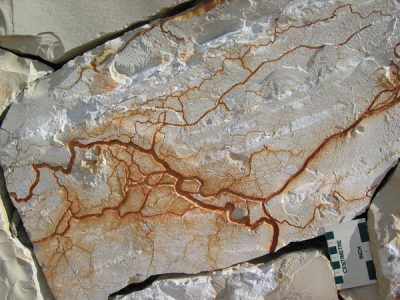The mechanisms of karstification
PDF
The engine is commonly gravity. The stronger the potential hydraulic gradient between the recharge surface and the emergence, the easier the groundwater flow will be, and therefore the more efficient the transport and disposal of dissolved materials. To gravity can be added a gradient of density, related to the mixture of fresh water and salt water (in the case of coastal aquifers), or of temperature due to the mixture between thermal water and fresh water.
The most common solvent is rainwater and all surface water that infiltrates, made acidic by the dissolution of CO2, which is highly soluble in water. The infiltration water takes on CO2 and becomes sufficiently acidic to dissolve the carbonate rocks at depth [3]. It transports and disperses CO2 underground, permanently maintaining its dissolving power. The Earth’s atmosphere contains little (partial pressure of CO2 : 0.035%) and rain dissolves about 30 mg/L of calcium carbonate CaCO3. But life in soils produces a lot of CO2 that accumulates there until it is 100 times more abundant than in outdoor air (pCO2: 2 to 4%), allowing the dissolution of 250 to 350 mg/L of CaCO3.
The more water and CO2 infiltrating, the faster the karstification process is. The amount of water infiltrating is determined by precipitation on the recharge area and by any surface runoff that is lost to carbonate rock after sinking on impermeable ground. This amount of water therefore depends on the climate and the geometry of the reservoir. The partial pressure of CO2, determined by the vegetation cover and air temperature, also depends on the climate. Other solvents have been identified in the interaction of groundwater with deep-seated gases, such as H2S and hydrothermal CO2, or in the freshwater-salt water mixture. These solvents are at the origin of particular forms and organizations of voids and drainage of karst aquifers, such as hydrothermal karst and coastal karst [4].
Different independent approaches show that a conventional network of karst conduits is built in a few tens of thousands of years, i.e. faster than a river network [5]. As a result, karst is very sensitive to geological events that may change the base level and the original permeability of the rock. All karst specialists now agree that all carbonate formations have been karstified to varying degrees over geological time [6].
References and notes
[1] Bakalowicz, M. (1979). Contribution of water geochemistry to the knowledge of the karst aquifer and karstification. PhD thesis in Natural Sciences. Dynamic Geology Laboratory, CNRS Underground Laboratory. University P. and M. Curie, Paris.
[2] Mangin, A. (1994). Karst hydrogeology. In: Groundwater Ecology, 43-67. J. Stanford, J. Gibert and D. Danielopol, Ed., Academic Press.
[3] Bakalowicz, M. (1979). Contribution of water geochemistry to the knowledge of the karst aquifer and karstification. PhD thesis in Natural Sciences. Dynamic Geology Laboratory, CNRS Underground Laboratory. University P. and M. Curie, Paris.
[4] Bakalowicz, M. (1996). The karstification processes and the different types of karst associated with them. Memo. Geol. couch France, 169, 363-371.
[5] Bakalowicz, M. (1992). Water geochemistry and dissolved matter flow. The objective approach to the role of climate in karstogenesis. In: Karst and climate change. Tribute to Jean Nicod. Presses Universitaires de Bordeaux, Talence.
[6] Chen, Z., Auler, A. S., A. S., Bakalowicz, M., Drew, D., et al. (2017). The World Karst Aquifer Mapping project: concept, mapping procedure and map of Europe. Hydrogeology J. , 25, 771-785.




